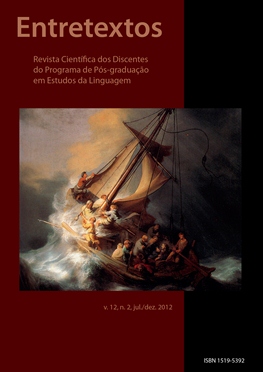The influence of personality traits on the silence of advanced level English language students
DOI:
https://doi.org/10.5433/1519-5392.2012v12n2p152Keywords:
Language teaching and learning, Individual diferences, Oral production. Silent period, Advanced levels of studyAbstract
The aim of this work is to investigate personality traits that could be related to the silence (in the classroom) of students of English as a foreign language at advanced levels of study. According to Krashen’s “silent period” concept, it is natural that students at the beginning of the learning process of a new language go through a period in which they remain silent, just receiving linguistic input, until they have acquired some knowledge and the necessary confidence to start talking. Some students, however, tend to remain silent in class, even at higher levels of language study. In this investigation, we focus on how these students act in class. This work is based on studies about personality traits involved in the language teaching and learning process carried out by Brown (2000), Ellis (1996), among others. The methodology of the research involves interviews, field notes, questionnaires, student´s retrospective self- evaluation, and audio and video recordings with students from two intermediate- advanced level groups and three advanced level groups of a private language institute. The goal is to identify and discuss possible factors that contribute to the lack of oral participation of these students in class, as well as their beliefs regarding the foreign language teaching and learning process, especially as it is related to oral practice. Through this work we verified, for example, that a personality trait like introversion may lead some students to prefer individual work – and contact with the textbook – to working with their classmates. When they are asked to work in pairs, in order to practice the target language, these students tend to speak as little as possible, focusing their attention on the book or notebook, while others are still interacting.Downloads
References
ALMEIDA FILHO, J.C.P.; SCHMITZ, J.R. Glossário de linguística aplicada. Campinas: Pontes, 1998.
BARBIRATO, R.C. Tarefas geradoras de insumo e qualidade interativa na construção do processo de aprender LE em contexto inicial adverso. Tese de Doutorado, UNICAMP, 2005.
BROWN, H.D. Principles of language learning and teaching. 4. ed. New York: Pearson Education Company, 2000.
DEWAELE, J-M; FURNHAM, A. Extraversion: The unloved variable in applied linguistic research. Language Learning, v. 49, n. 3, p. 509-544, 1999.
DORNYEI, Z. The psychology of the language learner: individual differences in second language acquisition. Mahwah: Lawrence Erlbaum Associates, Inc., 2005.
DIAS, E. Falar ou não falar?: Eis a questão! Dissertação de Mestrado, UNESP, 2003.
ELLIS, R. The study of second language acquisition. 4. ed. Oxford University Press, Oxford, 1996.
GRANGER, C.A. Silence in second language learning: a psychoanalytic reading. Clevedon et al: Multilingual matters, 2004. 142 p. (Second language acquisition 6).
MACINTYRE, P. D.; MACMASTER, K.; BAKER, S. C. The convergence of multiple models of motivation for second language leaming: Gardner, Pintrich, Kuhl, and McCroskey. ln: DORNYEI, Z.; SCHMIDT, R. (Eds.). Motivation and second language acquisition (Technical Report, 23, p. 461-492. Honolulu: University of Hawai'i, Second Language Teaching and Curriculum Center, 2001.
MACINTYRE, P. D.; CLEMÉNT, R.; DORNYEI, Z.; NOELS, K. A. Conceptualizing willingness to communicate in a L2: a situational model of L2 confidence and affiliation. The Modern Language Journal, v. 82, n. 4, p. 545-562, 1998.
MCCROSKEY, J.C.; RICHMOND, V.P. Willingness to Communicate: a cognitive view. Journal of Social Behavior and Personality, n. 5, p. 19-37, 1990.
TOLEDO, F. B. O silêncio dos aprendizes: um estudo sobre o “período silencioso prolongado” de aprendizes de língua estrangeira (Inglês). Dissertação de Mestrado, UFSCAR, 2010.
Downloads
Published
How to Cite
Issue
Section
License
Entretextos adota a Licença Creative Commons Attribution 4.0 International, portanto, os direitos autorais relativos aos artigos publicados são do/s autor/es.
Sob essa licença é possível: Compartilhar - copiar e redistribuir o material em qualquer suporte ou formato. Adaptar - remixar, transformar, e criar a partir do material, atribuindo o devido crédito e prover um link para a licença e indicar se mudanças foram feitas.






















